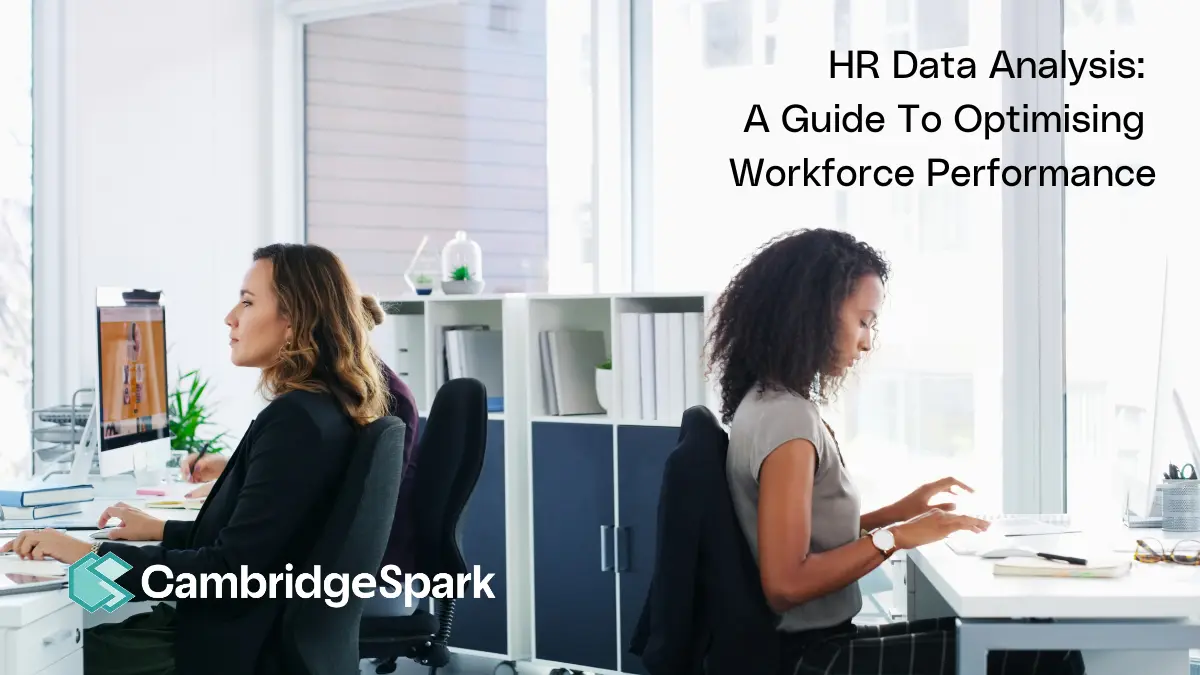Analysing HR data plays a crucial role in driving organisational success. Seventy percent of executives view people analytics as a top priority within their organisations.
And the market for HR analytics is only expected to surge in the future.
Organisations that fail to harness the power of HR analytics risk falling behind, especially as the trend towards digitisation continues to grow.
.webp?width=1050&height=591&name=HR%20data%20analytics%20(1).webp)
Why HR data analysis matters
Data-driven decision-making has become paramount in the digital era. For HR, this means leveraging data to gain insights into employee behaviour, performance, and overall company culture.
 “It felt like there was this underlying world that I couldn't get to and couldn't do anything with and that was my main motivation. I really wanted to learn and do more with what we had in terms of data, to make the most of it. And data is so important. It's a bit of a buzzword but it's because we have so much of it now and we have to make sure that we're using it!” - Sammy Baylis, Human Resources Operations Manager, Teach First
“It felt like there was this underlying world that I couldn't get to and couldn't do anything with and that was my main motivation. I really wanted to learn and do more with what we had in terms of data, to make the most of it. And data is so important. It's a bit of a buzzword but it's because we have so much of it now and we have to make sure that we're using it!” - Sammy Baylis, Human Resources Operations Manager, Teach First
With the right data, HR data analysts can predict trends, identify areas of improvement, and make strategic decisions that align with the company's goals.
For instance, companies like Google use data analytics in HR to understand the dynamics of effective teams and then apply those insights to other teams across the organisation.
Beyond recruitment, HR data analysis plays a pivotal role in talent management, performance evaluation, and employee engagement. By analysing HR data, companies can identify patterns, predict employee turnover, and even forecast future hiring needs.
This proactive approach ensures that organisations remain agile and competitive in the ever-evolving business landscape.
Understanding the types of HR data
There are 3 types of data analytics commonly used in HR:
- Descriptive analytics: Provides a snapshot of past HR activities, such as the number of hires in a month or year.
- Predictive analytics: Forecasts future trends based on historical data, like predicting employee turnover rates.
- Prescriptive analytics: Offers recommendations on actions to take, such as training programmes to reduce skill gaps.
Data collection methods
Collecting accurate and relevant data is the cornerstone of any successful HR analytics initiative. The methods used to gather this data can vary based on the specific objectives of the analysis. Here's a deeper dive into some of the most common data collection methods in HR:
Employee surveys
One of the most direct ways to gauge employee sentiment are with surveys. Surveys can be tailored to gather feedback on a wide range of topics.
Whether it's understanding job satisfaction, getting feedback on a recent company event, or assessing the effectiveness of a new workplace policy. Surveys offer a snapshot of employee feelings at any given point in time.
Tools like SurveyMonkey or Google Forms can be used to design and distribute these surveys, ensuring anonymity and encouraging honest feedback.
Performance reviews
These periodic evaluations are a goldmine of data. They provide insights into an employee's strengths, areas of improvement, goals, and achievements.
By analysing performance review data, HR can spot patterns, such as common areas where employees excel or frequent challenges they face. This data can then inform training programmes, mentorship initiatives, and other HR interventions.

Real-time analytics platforms
With the rise of digital tools in the workplace, real-time analytics have become increasingly relevant. Platforms like Microsoft Teams or Slack, when integrated with analytics tools, can provide insights into daily employee activities.
For instance, how often are team channels used for collaboration? Are certain company-wide channels more active than others? This real-time data can offer a glimpse into employee engagement, collaboration patterns, and overall company culture.
Exit interviews
When an employee leaves the company, exit interviews can provide valuable insights into their reasons for departure. This data can highlight potential areas of improvement, from compensation packages to workplace environment, and can be instrumental in reducing future turnover and improving overall employee satisfaction.
Attendance and time tracking
Tools that monitor employee attendance, punctuality, and work hours can offer insights into work patterns. For example, are there frequent latecomers in a particular department? Is overtime a common occurrence? This data can inform decisions related to staffing, work distribution, and even workplace well-being initiatives.
Data cleaning and preparation
In the realm of data analytics, the adage "garbage in, garbage out" holds true. Before embarking on any analytical journey, ensure that the data you have is clean, consistent, and reliable. “Dirty” or inconsistent data, riddled with inaccuracies, missing values, or duplicates, can skew results and lead to misguided insights.
The process of data cleaning involves a few steps.
- Identify and handle missing values - these could be filled using techniques like imputation or simply removed, depending on the dataset's size and nature.
- Find and remove any duplicate data entries to ensure each data point is unique and accurate.
- Ensure data is consistent - this means ensuring that data formats, units, and scales are uniform across the dataset. For instance, if one entry reads "10%" and another "0.10", standardising these values ensures more accurate analysis.
Modern tools and programming languages have made the data cleaning process more efficient. Libraries like Pandas in Python offer a suite of functions to streamline data cleaning, from handling missing values to converting data types.
HR data analysis tools
The world of HR analytics is filled with tools designed to extract, analyse, and visualise data. Here's a closer look at some of the most popular ones:
- Tableau: A leading data visualisation tool, Tableau allows users to create interactive and shareable dashboards. These dashboards can display trends, variations, and patterns in the data, making it easier for HR professionals to derive insights at a glance.
- Power BI: Developed by Microsoft, Power BI is another powerful data visualisation tool. It integrates seamlessly with various data sources and offers a range of visualisation options. It's cloud-based, so HR teams can access data and insights anytime, anywhere.
- Python: A versatile programming language, Python is widely used in data analysis due to its powerful libraries like Pandas for data manipulation and Matplotlib and Seaborn for visualisation. Python Scikit-learn also offers tools for predictive analytics, making it a favourite among data scientists and HR analysts alike (related: Python vs Excel for Data Analysis).
Key HR metrics to track
In the dynamic landscape of HR, metrics serve as the compass guiding strategic decisions. They offer a quantifiable measure of HR's effectiveness, revealing both strengths and areas of improvement.
Below are some key HR metrics to track:
- Voluntary turnover rate: This metric reveals how many employees willingly leave the organisation. A high rate could signal underlying issues, such as workplace dissatisfaction or non-competitive compensation packages.
- Online ratings: Online ratings by staff gauge employees' perspectives on their workplace. They reveal insights into company culture, management effectiveness, and job satisfaction. These ratings influence potential hires, providing companies feedback for internal improvements and employee retention strategies.
- 1:1 meetings: 1:1 meetings in HR are private, scheduled sessions between an employee and their manager. They provide a platform for open dialogue, feedback exchange, goal setting, and addressing concerns, fostering a stronger working relationship and enhancing employee engagement and performance.
- Performance ratings: Derived from regular evaluations, these ratings provide insights into individual and team achievements. Consistently low ratings in a department might indicate the need for additional training or resources.
By diligently tracking these and other relevant metrics, HR professionals can gain a holistic view of the organisation's health, enabling them to implement targeted strategies that drive growth and enhance employee satisfaction.
Data visualisation in HR
Visualisation plays a pivotal role in translating complex data into digestible and actionable insights. It's not just about presenting numbers. It's about telling a compelling story that drives decision-making. Here are some common techniques for visualising HR data:
- Bar charts: One of the most common visual tools, bar charts can effectively represent data like department-wide turnover, monthly recruitment rates, or training attendance. By comparing the lengths of bars, HR professionals can quickly identify trends or anomalies.
- Heatmaps: These are especially useful for showcasing employee engagement levels across different departments or locations. By using colour gradients, heatmaps can instantly highlight areas of high or low engagement, allowing HR to pinpoint where interventions might be needed.
- Pie charts: Ideal for representing parts of a whole, pie charts can depict metrics like the distribution of employees across various roles, age demographics, or the percentage of employees who have undergone specific training.
- Line graphs: Perfect for tracking changes over time, line graphs can illustrate trends in metrics like monthly employee satisfaction scores or yearly attrition rates.
- Interactive dashboards: With advancements in technology, interactive dashboards have become increasingly popular. Tools like Tableau or Power BI allow users to drill down into specific data points, offering a more detailed view and facilitating deeper analysis.
In essence, the right visualisation not only simplifies complex data but also highlights key insights that might otherwise go unnoticed. For HR professionals, this means making informed decisions that align with organisational goals and drive positive change.
Data visualisation also helps communicate valuable findings to other departments within the company, senior management teams and stakeholders, making collaborative efforts to drive the business forward more effective and streamlined.
Employee performance analytics
Performance data serves as a rich repository of insights that can significantly impact an organisation's talent management strategy. By meticulously analysing this data, HR departments can make informed decisions on multiple fronts:

Identifying high-performers
Through metrics like project completion rates, customer feedback, and peer reviews, HR can pinpoint employees who consistently outperform their peers. Recognising and rewarding these high-performers can boost morale and set a standard for excellence within the organisation.
Spotting future leaders
Leadership potential often manifests in subtle ways, such as an employee's ability to collaborate effectively, solve problems creatively, or inspire team members. By tracking these softer metrics alongside traditional performance indicators, HR can identify potential future leaders for development programmes.
Targeting support and training
Not all employees perform at the same level, and that's okay. Performance analytics can help HR identify those who may be struggling and could benefit from additional resources or training.
Whether it's a new software tool or a soft skills workshop, targeted interventions can help these employees improve and contribute more effectively.
Customising career paths
With a comprehensive view of each employee's strengths and weaknesses, HR can offer more personalised career development advice, from suggesting lateral moves to recommending specific upskilling programmes.
Gender and diversity analytics
In an increasingly interconnected and globalised business landscape, fostering diversity and inclusion is not just a moral obligation—it's a strategic imperative.
Organisations that prioritise diversity often outperform those that don't, benefiting from a broader range of perspectives, improved problem-solving, and enhanced innovation. In fact, organisations in the top quartile for gender diversity have a +25% likelihood of financially outperforming their peers.
- Gender pay gap analysis: One of the most critical metrics to consider is the gender pay gap. By analysing salary data across genders for similar roles and responsibilities, organisations can identify and address any disparities, thereby promoting a fairer workplace.
- Representation metrics: Beyond gender, it's essential to look at the representation of various ethnicities, age groups, and other demographic factors within the organisation. Are all groups represented at all levels, including leadership? If not, targeted recruitment and development programmes may be needed.
- Inclusion surveys: Regular surveys can gauge the sense of belonging among diverse groups within the organisation. Low scores among specific demographics can be a red flag, indicating the need for immediate action to foster a more inclusive environment.
%20(1).webp?width=1050&height=591&name=Survey%20(1)%20(1).webp)
- Attrition rates: Analysing attrition rates among different demographic groups can offer insights into potential issues within the company culture. A higher turnover rate among specific groups could indicate systemic issues that need to be addressed.
- Promotion and advancement analytics: Are all groups equally likely to be promoted or to advance within the organisation? If not, it may be worth investigating whether unconscious biases are influencing these decisions.
By leveraging gender and diversity analytics, companies can take a data-driven approach to fostering an inclusive environment. This not only enhances the well-being of all employees but also contributes to a more innovative and adaptable organisation.
Learning and development analytics
Investing in employee training and development is often a substantial financial commitment for organisations.
However, at Cambridge Spark, all of our apprenticeship programmes are funded by the UK apprenticeship Levy. This effectively means you can upskill your team with no additional costs to your organisation.
Learning and Development (L&D) analytics offer a way to measure the overall impact of training initiatives.
- Pre-training and post-training performance metrics: One of the most direct ways to measure training effectiveness is by comparing performance data before and after the training period. Metrics could include productivity levels, error rates, or customer satisfaction scores. A significant improvement in these metrics post-training can validate the effectiveness of the programme.
- Skill assessments: Many organisations use skill assessments to gauge the technical or soft skills of employees before and after training. A marked improvement in assessment scores can be a strong indicator of training effectiveness.
- Employee surveys: Post-training surveys can provide qualitative insights into how employees perceive the value of the training programmes. Questions can focus on the relevance of the training content, the quality of the instructors, and the applicability of the skills learned.
- Long-term impact: While immediate changes are essential, it's also crucial to track the long-term impact of training programmes. Are the skills learned being applied consistently over time? Is there a sustained improvement in performance metrics?
Data security in HR analytics

With the increasing digitisation of HR processes, vast amounts of sensitive employee data are stored and analysed. This data, ranging from personal details to performance metrics, is invaluable for making informed HR decisions. However, it's also a potential target for cybercriminals.
Breaches can lead to not only financial repercussions but also damage to an organisation’s reputation and trust. Organisations must implement robust cybersecurity measures to safeguard this data.
Protecting sensitive employee data is a critical responsibility for every organisation.
Here are our top tips for keeping your HR data secure:
- Start by limiting HR data access to only those who genuinely need it.
- Employ robust encryption methods for data both in transit and at rest.
- Regularly update and patch software to guard against vulnerabilities.
- Implement multi-factor authentication for systems containing confidential information.
- Educate employees about phishing scams and the importance of strong, unique passwords.
- Conduct periodic security audits to identify potential weak points and address them proactively.
Remember, safeguarding employee data isn't just about compliance. It's about maintaining trust and integrity.
Integrating HR data with other departments within your organisation
HR data, often seen as confined to talent management, has broader effects that ripple across various departments within a business.
- Marketing - understanding employee skill sets and expertise can aid in crafting authentic brand narratives, showcasing real talent behind products or services. This authenticity can resonate with consumers, enhancing brand loyalty.
- Sales - HR data on training and development can pinpoint areas where sales teams excel or need improvement, allowing for targeted training that boosts sales performance. Knowledge of peak productivity times and patterns can also help in scheduling critical sales calls or meetings.
- Finance - HR data provides insights into workforce costs, helping in budgeting and forecasting. It can also highlight patterns in employee turnover, enabling finance to anticipate and plan for recruitment or training costs.
HR data, when leveraged correctly, is an incredible source of insights that can drive efficiency and strategy not just in human resources, but across the organisational spectrum.
Future trends for data analytics in HR
HR analytics is poised for transformative shifts. Artificial intelligence and machine learning will play pivotal roles, automating routine tasks and offering predictive insights on talent acquisition and retention.
We predict people analytics will move beyond traditional metrics, delving into employee well-being and mental health. Real-time feedback systems will replace annual reviews, fostering continuous growth.
Additionally, the integration of virtual reality in training will enable immersive learning experiences.
As remote work becomes commonplace, analytics will focus on measuring digital engagement and productivity.
Ultimately, the future of HR data analysis lies in its ability to merge technology with human-centric approaches, driving both efficiency and empathy.
Looking to upskill your HR team in data analysis?
At Cambridge Spark, we offer a tailored and publicly funded Data Citizen Apprenticeship with People Analytics Pathway which includes content from the Chartered Institute of Personnel and Development (CIPD).
The apprenticeship upskills learners with the ability to contextualise what they have learnt in their Data Citizen Apprenticeship towards people functions. And they can gain a better understanding of how data can be used to inform key HR decisions.
“I'm really proud to say that I've finished this apprenticeship. I didn't even know how to open Python before, so for me to have come from that and wrote a script where I can reduce a day's work to under one second is a massive accomplishment to me and I'm happy!” - Sammy Baylis, Human Resources Operations Manager at Teach First and Data Analyst Apprentice
Get in touch with us today to start your data transformation journey.
